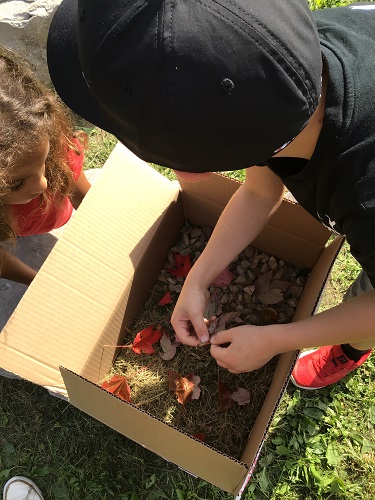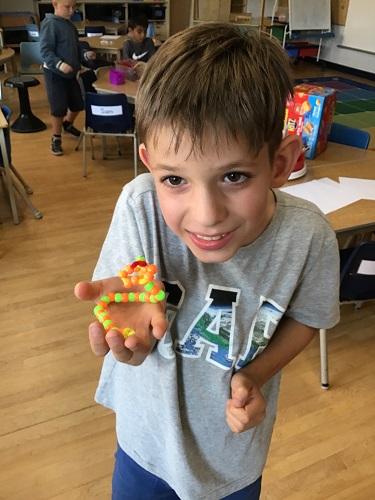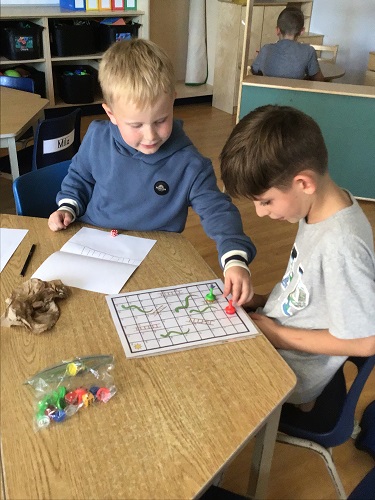Forrest had found a cardboard box in his classroom at school and brought it with him to RisingOaks. I asked him what he wanted to do with the box and he responded with a shoulder shrug to indicate he was unsure. I asked him if he had some ideas of what he could do with the box.
He responded, “I use it to create a diorama like I did in school last year.”
“What type of a diorama would you create?” I responded.
“Maybe a snake habitat! I found some snakes in our garden and created a home for them in an aquarium at my house!” Forrest continued with a huge smile on his face.
Emerson had approached us during our conversation, “why don’t we make our own snake habitat and go hunting for snakes!”
The two agreed that this was what they wanted to do with the box. Once outside, a few of the other children asked what they were doing. Once they learned that Emerson and Forrest wanted to make a snake habitat and go hunt for snakes, the others asked to join in! As the children were outside looking over, under, and around their natural environment, they were calling to each other to take a look at what they found. This relates to our foundation of Belonging as the children “express joy and wonder in their encounters with the environment, the natural world, and other people.” (HDLH, 2014)
The children ran around the playground discussing the various items they feel belong in the snake habitat. There was discussion on what the snakes need to survive, what they eat, and if they drink. Forrest seemed to have an in-depth understanding of all things snakes and was the person the children went to for any questions they might have. The children ran around the playground collecting rocks, dirt, sticks, logs, and leaves. The conversations around what the snakes need and how everyone was helping out to create a habitat for the snakes, coincides with our foundation of Well-Being in that the children “are increasingly able to recognize, value, and respect the unique identity and perspectives of others.” (HDLH, 2014)
While inside, the children had the opportunity to create their own snake patterns using beads and pipe cleaners. The children discussed the different types of patterns they were creating, some had a simple AB pattern, while some chose to create an AABBCC type pattern.
“Wow, I love your pattern Caden” I heard Spencer exclaim as he was sitting at the table creating his pattern.
“Spencer, I like how you used those colours for your snake!” Kyrielle said.
The children then took it upon themselves to hide their snakes around the room to have their peers go and find them. The discussions heard favour our foundation of Engagement, how the children “engage with others to negotiate, collaborate, create, and communicate feelings, ideas, experiences, and knowledge.” (HDLH, 2014)
Another activity that the children participated in was our Snakes and Ladders game. The children each took a turn rolling the dice and moving their player the correct amount of spaces. The children helped each other out and cheered each other on when they landed on a ladder to advance to a higher space. The children also encouraged each other “that’s okay, you’ll land on a ladder next time” if the child landed on a snake and had to slide down. The children were demonstrating a sense of Expression in that they “initiate, respond to, and engage in reciprocal communication with others.” (HDLH, 2014)
Continuing with the children’s interest in snakes, the educators decided to implement a science experiment for the children. We talked about what happens when you mix baking soda and vinegar, “a volcano!” the children responded. We discussed how there is a chemical reaction between baking soda and vinegar. We asked the children what they think would happen if we soaked the gummy snakes in baking soda and water for 20 minutes and then placed them in a cup of vinegar. The children had various answers, the gummy snakes would explode, they would fizz and jump out of the cup. Each child was given a turn to take part of the experiment, some children helped to cut the gummy snakes, some children mixed the baking soda and water and each child had a chance to place a gummy snake in the vinegar. It was interesting listening to what the children thought would happen and then discussing what they actually observed happening. This experiment helps to foster a sense of Belonging as we “notice similarities and differences between self and others and respond positively to the uniqueness, different capabilities, and perspective of others.” (HDLH, 2014)
Some other table top activities that we had available to the children were a “Spot the Difference”, where there were two photos side by side that looked very similar, however, there were 10 hidden differences. The children worked together and independently to find these differences. The children also created their own snake trail painting by using a piece of string, pulled it through some paint and then ran the string along the paper to create a resemblance of the trail a snake might make in the mud. The children also practiced their fine motor and hand-eye coordination while trying to run a water droplet down the body of snake until they reached the pot at the bottom of the page.
Although the children showed an immense interest in snakes, creating a habitat and hunting for snakes, it was interesting to observe how that interest was carried over into their day to day. The children continued to be engaged in the activities that were provided and creating their own activities around snakes. Some children used feathers to glue on sticks to create a new species of snakes.
We worked on our math skills with patterning, our creative skills with string painting, and creating a habitat, we developed our language and social skills by playing Snakes and Ladders and researching information about snakes. Throughout the entire experience, the children were participating and engaging in dialogue and activities revolving around snakes! Throughout the remainder of the month, we will continue our discussion on snakes, the snakes body parts, the various types of snakes, what all the different type of snakes eat, and more. I am interested to find out where these discussions may lead, will we continue on with snakes, or will our interest spread somewhere else, maybe we will learn about the food chain. Only time will tell.












